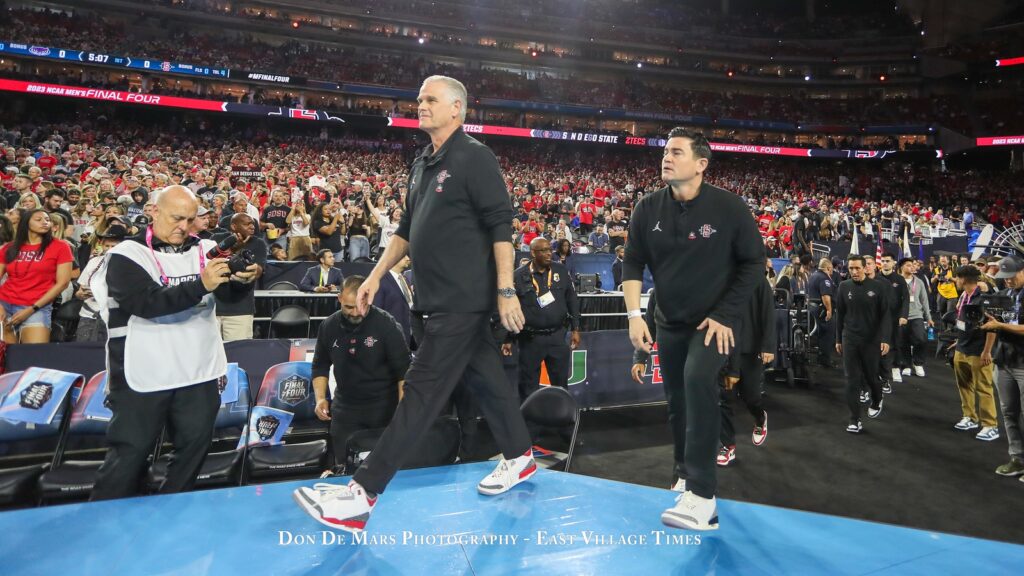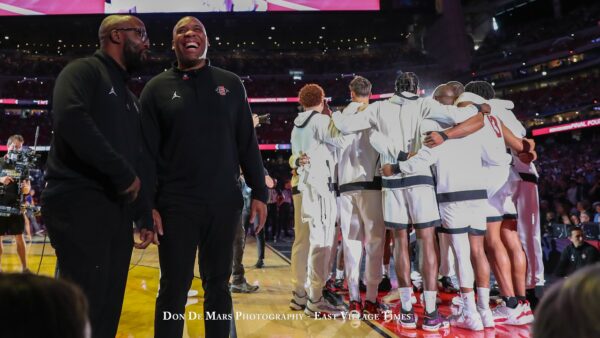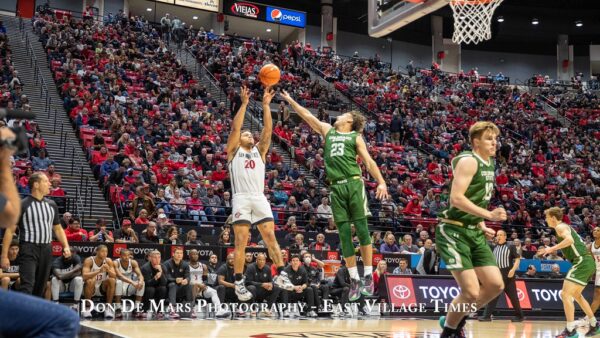Freedom within framework: The building of SDSU’s offense

Brian Dutcher walks onto the court before SDSU plays FAU. (Don De Mars/EVT)

San Diego State Men’s Basketball head coach Brian Dutcher describes his offensive system as “freedom within framework.”
The defining characteristic of the Aztecs’ approach is the flexibility it provides to the coaches and players. Instead of a rigid attack that Dutcher and his staff recruit athletes to, SDSU attracts the best possible players and builds its offense around them.
“A lot of it is who’s on your roster,” SDSU assistant JayDee Luster told EVT in an exclusive interview. “And I think coach Dutcher does a good job of evaluating, seeing exactly what we have as far as guys strengths and weaknesses and then scripting the offense that kind of caters to those.”

SDSU’s changing offenses
In 2020-2021, the Aztecs were led by Matt Mitchell and Jordan Schakel. Dutcher utilized a mover-blocker scheme to create shots early in the shot clock. That action morphed into a 4-out offense to get his best players the ball in space.
He played Mitchell as an undersized power forward, ran Schakel off multiple screens, and used Nathan Mensah in the pick-and-roll with elite shooters Terrell Gomez and Adam Seiko as threats in the initial action or to create spacing as the possession developed.
Two seasons later, Matt Bradley was the offense’s best player. Unlike Mitchell and Schakel, Bradley worked best in isolation.
Early in 2022-2023, teams took away Bradley’s strength by camping a center in the key, forcing Bradley to shoot further out. Dutcher adapted his offense to combat the tactic by having two players duck in on nearly every possession.
As Bradley or any wing player made their move, Mensah, Keshad Johnson, or Jaedon LeDee would engage the sagging center. They would seal the opposing big, creating space for the driver or themselves by pinning their man on their back away from the basket. Instead of spreading the floor, Dutcher clogged the lane because it fit the strengths of his personnel.
The Aztecs rode the double duck-ins to the national title game, but the approach was not featured at the beginning of the year. An embarrassing 87-70 loss to Arizona in the Maui Invitational in late November catalyzed the adjustment.
Last year, with Bradley, Mensah, Seiko, and Johnson gone, the offense revolved almost exclusively around Jaedon LeDee. On his way to earning All-American honors and the Karl Malone Award as the nation’s best power forward, LeDee took 160 more shots and 212 more free throws than his next closest teammate.
As with the previous iterations, Dutcher did not intend to take this approach going into the season; it was discovered as the season unfolded.
“Earlier in the year last year, we weren’t playing through Jaedon as much,” Luster explained. “But, once December, January came, it was, okay, in order for us to be successful, (LeDee needs) to touch the ball on each possession. (He) don’t have to shoot it, but we need to make an emphasis on him touching this ball. So, it’s always changing, and we’re always evolving and trying to put these guys in the best situations.”

Building SDSU’s attack
SDSU’s offense begins with a series of actions. What happens after these initial movements is up to the athletes’ discretion. Depending on the quality of the defenders, how an Aztec is shooting that night, or where a player is most comfortable scoring on the court, the same starting framework can have different secondary responses on multiple trips down the floor.
Dutcher might call for the center to screen for a point guard, but the athlete has the freedom to make a play. In different sequences, the big might slip the screen and dive to the basket, float behind the three-point line after the screen, roll to the rim in a pick and roll, or take a pass and move into a dribble handoff.
There are no rules that govern what they do. The choice is theirs.
The art of coaching involves considering all possible outcomes and guiding players to make choices that lead to winning. This process begins in the summer, plays out during the season, and leads to SDSU playing its best ball in March.
“It’s more so playing off the concepts and reading and reacting,” Luster said. “And those guys playing together and understanding what each other is good at and what each others’ weaknesses are and then being able to create plays based on that.”
During summer workouts, the staff places the players in various situations and lets them compete. In one practice segment, they might play three-on-three and let the Aztecs run off screens. Another might be dedicated to bringing the ball up the court. Regardless of position, every Aztec participates in pick-and-rolls, stagger screens, zoom actions, and other game-like situations.
They compete at the elbows, in the post, or on the wings without the coaches dictating play. As they do, everyone learns what each individual does best. The staff watches the action unfold and the tape afterward to scout their players.
After this experimental phase, the team comes together for the practices leading to the first game. At this juncture, the staff has a good feel for their players and the structures they want to implement. The rest of the preseason is left to determine who SDSU’s go-to players will be.
As the season unfolds, in addition to tweaking the scheme, the staff coaches the players to exercise their freedom properly.
For example, they might call a stagger-screen, running Reese Waters off two picks by Magoon Gwath and Nick Boyd. With the ball in his hands, Waters can pull up, drive to the basket, give the ball back to Boyd coming off Gwath’s secondary single screen, or wait for Gwath to enter a pick-and-roll with him. The staff’s job is to study film with Waters to help him make great decisions.
“This is the framework, and you guys got to be smart enough to understand my strengths and weaknesses within that framework,” Luster said, describing the staff’s message to the players.

Player Confidence
The beauty of this approach is that it makes the Aztecs hard to scout. Usually, only conference foes have enough feel for SDSU to limit the variations its offense can take. The unpredictability of the NCAA Tournament meshes well with how Dutcher leads his program. It is also attractive from a player development perspective.
Even with NIL, athletes view college as a stepping stone to their professional careers. SDSU is dedicated to maximizing its players’ abilities, not the precision of its system. Dutcher encourages growth and a variety of skills as a result.
“It’s huge,” Luster replied when asked how SDSU’s approaches help its players. “It gives them confidence knowing that we’re in it with them and we’re trying to figure out what’s best for them. We’re not one of these coaching staffs that’s close minded and think we have all the answers. It’s a process, and we’re figuring it out as we go, just like them.”
“One of the things Dutch always says after games or throughout the season, ‘If there’s a way I can help, or if there’s something I’m doing wrong as far as how I’m using you, my door is open. Come talk to me.’”
“It’s them knowing that we’re all in it together. Them knowing that if they are good at something, we’re going to find a way to highlight that. I think it gives them a great deal of confidence. It’s one of the reasons why guys love playing for coach Dutcher.”
SDSU’s offense is taking shape leading up to the season opener against UC San Diego. Luster spoke to EVT the day before the Aztecs’ first official practice. He gave details about the roster’s new additions, stylistic changes, and the philosophy that the 2024-2025 offense will be built upon.
A later article will cover this season’s squad in more detail. How the team looks at the beginning of the year will not be its identity in March. The freedom Dutcher gives his athletes in the framework he provides promises an open process that typically ends with Aztec victories.
My earliest sport’s memory involve tailgating at the Murph, running down the circular exit ramps, and seeing the Padres, Chargers and Aztecs play. As a second generation Aztec, I am passionate about all things SDSU. Other interests include raising my four children, being a great husband and teaching high school.